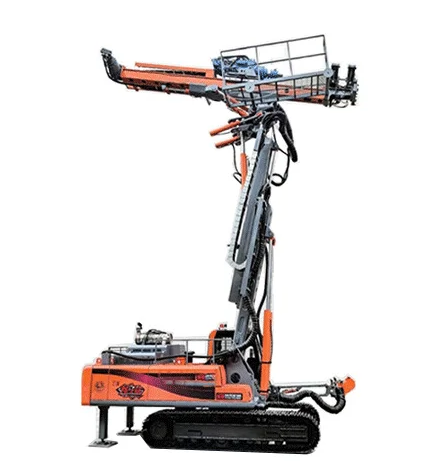 English
English שפה עברית
שפה עברית  Kurdî
Kurdî  Español
Español  Português
Português  русский
русский  tiếng Việt
tiếng Việt  ภาษาไทย
ภาษาไทย  Malay
Malay  Türkçe
Türkçe  العربية
العربية  فارسی
فارسی  Burmese
Burmese  Français
Français  日本語
日本語  Deutsch
Deutsch  Italiano
Italiano  Nederlands
Nederlands  Polski
Polski  한국어
한국어  Svenska
Svenska  magyar
magyar  বাংলা ভাষার
বাংলা ভাষার  Dansk
Dansk  Suomi
Suomi  हिन्दी
हिन्दी  Pilipino
Pilipino  Gaeilge
Gaeilge  Indonesia
Indonesia  Norsk
Norsk  تمل
تمل  český
český  ελληνικά
ελληνικά  український
український  Javanese
Javanese  தமிழ்
தமிழ்  తెలుగు
తెలుగు  नेपाली
नेपाली  български
български  ລາວ
ລາວ  Latine
Latine  Қазақша
Қазақша  Euskal
Euskal  Azərbaycan
Azərbaycan  Slovenský jazyk
Slovenský jazyk  Македонски
Македонски  Lietuvos
Lietuvos  Eesti Keel
Eesti Keel  Română
Română  Slovenski
Slovenski
What is the Science Behind Jet Grouting with High Pressure Rigs?
2025-10-17
What is the Science Behind Jet Grouting with High Pressure Rigs?
Jet grouting, executed by a high pressure rotary jet drilling rig, is a ground improvement technique that appears deceptively simple but is underpinned by complex principles of fluid dynamics, soil mechanics, and rheology. The process involves the injection of a cement grout slurry at ultra-high pressures to erode and mix with the in-situ soil, forming a engineered composite material known as soil-cement. The scientific effectiveness of this method lies in the controlled application of kinetic energy to disrupt the soil fabric and the subsequent chemical and physical bonding that creates a new, improved material.
The core scientific principle is the conversion of hydraulic energy into kinetic energy within a coherent fluid jet. The high pressure rotary jet drilling rig uses powerful pumps to pressurize the grout slurry to levels typically between 400 and 600 bar. This high-pressure fluid is then forced through small-diameter nozzles (usually 1.5 to 3.0 mm) at the monitor. According to the principles of fluid dynamics, this sudden expansion from a high-pressure zone to atmospheric pressure in the soil accelerates the fluid to supersonic velocities, creating a jet with immense kinetic energy. The coherence of this jet—its ability to stay together as a focused stream over a distance—is critical and is influenced by the nozzle design, fluid viscosity, and the use of air shrouds in double and triple fluid systems.

The interaction between this high-energy jet and the soil mass is governed by soil mechanics and erosion theory. The jet impinges on the soil with a stress that far exceeds the soil's shear and tensile strength. In granular soils (sands and gravels), the jet works by displacing individual particles and breaking the inter-granular locks. In cohesive soils (clays and silts), the mechanism involves shearing and remolding the soil fabric. The jet creates a cavity that is instantly filled and hydraulically fractured by the grout. The key is the simultaneous erosion and mixing. The high pressure rotary jet drilling rig controls the kinematics of this process—the rotation and withdrawal speeds—which determine the volume of soil treated and the homogeneity of the final mix. The relationship between these parameters and the resulting column diameter is a primary focus of jet grouting science.
The resulting soil-cement composite's properties are a function of the original soil's mineralogy and the cement chemistry. The grout slurry, a suspension of cement particles in water, interacts with the soil particles and pore water. In a process similar to concrete technology, the cement hydrates, forming calcium silicate hydrates (C-S-H) and other compounds that bind the soil particles together. The final unconfined compressive strength and permeability of the soil-cement are not solely dependent on the grout mix but are a product of the interaction. A sandy soil, being inert, will typically yield a higher strength material as the cement paste binds the hard particles. high pressure rotary jet drilling rig A clayey soil, with its active minerals, may engage in more complex reactions, but the strength is often lower due to the plasticity of the clay remnants. The high pressure rotary jet drilling rig's role is to ensure a uniform mix to achieve consistent properties throughout the column.
Therefore, the science of jet grouting with a high pressure rotary jet drilling rig is an interdisciplinary field. It requires an understanding of the jet's fluid mechanics to optimize its erosive reach, the soil's response to rapid hydraulic loading to predict the treated volume, and the chemo-physical interactions during mixing to engineer the final product's geotechnical properties. This scientific foundation allows engineers to move from an empirical art to a predictive modeling-based practice, designing jet grouting columns with specific characteristics for strength, stiffness, and permeability to meet the precise demands of a foundation or earth retention project.




